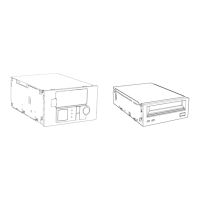Configuring Drives with Specific Systems
Apple/Macintosh Applications
(GLWLRQ¦ 2FWREHU
$SSOH0DFLQWRVK$SSOLFDWLRQV
& RQILJXUDWLRQ6ZLWFK6HWWLQJV
6ZLWFK21WRGLVDEOH056
$XWRORDGHU2SWLRQ6ZLWFK6HWWLQJV
'(&:RUNVWDWLRQV
& RQILJXUDWLRQ6ZLWFK6HWWLQJV
6ZLWFK21WRGLVDEOH056
7KH6&6,FRPPDQGVHWXVHGRQ'(&ZRUNVWDWLRQVGLIIHUVIURPWKDWRI6XQ
VLJQLILFDQWO\LQWKHXVHRIWKH
63$&(
FRPPDQG:KHUH6XQFRPSOLHVZLWKWKH
UHTXLUHPHQWVRI6&6,'(&XVHVD6&6,LPSOHPHQWDWLRQRIWKLVFRPPDQG
7KLVKDVDPDMRULPSDFWLID'(&XVHUZDQWVWRERRWIURPWDSH%\VHWWLQJVZLWFKWR
2))WKHGULYHDXWRPDWLFDOO\VZLWFKHVWRWKHIXQFWLRQDOLW\UHTXLUHGE\'(&
ZRUNVWDWLRQVWKHVWDQGDUG
,148,5<
GDWDOHQJWKLVWUXQFDWHGE\E\WHV7KLVDOORZV
WKHXVHUWRSOXJDQGSOD\RQ'(&ZRUNVWDWLRQV1RRWKHUFKDQJHVDUHUHTXLUHG
,IWRSSHUIRUPDQFHLVDUHTXLUHPHQWWKHGULYHFDQEHFRQILJXUHGWRRSHUDWHLQ
,PPHGLDWHPRGHDQGZLWK,QILQLWH)OXVK E\VHWWLQJERWKVZLWFKHVDQGWR2))7KLV
LPSURYHVWKHGULYHªVSHUIRUPDQFHE\UHGXFLQJWKHWLPHLWWDNHVWRZULWHILOHPDUNV
EHFDXVHDOOILOHPDUNFRPPDQGVZLOOEHWUHDWHGDVLPPHGLDWHFRPPDQGV7KH
GUDZEDFNKHUHLVWKDWLISRZHUIDLOVWKHKRVWPD\QRWEHDEOHWRZRUNRXWZKHUHGDWD
LVEHFDXVHDILOHPDUNVXSSRVHGWREHRQWDSHKDVQRZEHHQORVWLQWKHEXIIHU
)RU'(&$OSKD$;326)YDQGODWHU
7RDOORZWKHKRVWWRHQDEOHDQGGLVDEOHFRPSUHVVLRQDQGIRUJHQHUDOLPSURYHPHQWVLQ
KRVWFRQWUROIROORZWKHSURFHGXUHLQVWHSEHORZ8VHVWHSVDQGRQO\LIQHFHVVDU\
1
3 HUI RUPWKLVVWHSRQ O\ L I QHFHVVDU\
,QWKHILOH
/usr/sys/data/cam_data.c
PDNHWKHIROORZLQJDGGLWLRQWRWKH
cam_devdesc_tab
VWUXFWXUH
123 * 45678
On On Off On On On On On
1 2 3 4 Value
On On On Off 7
123 *45678 Comments
On On Off On On On On Off
'(&8OWUL[DQG906$OSKD
$;326)

